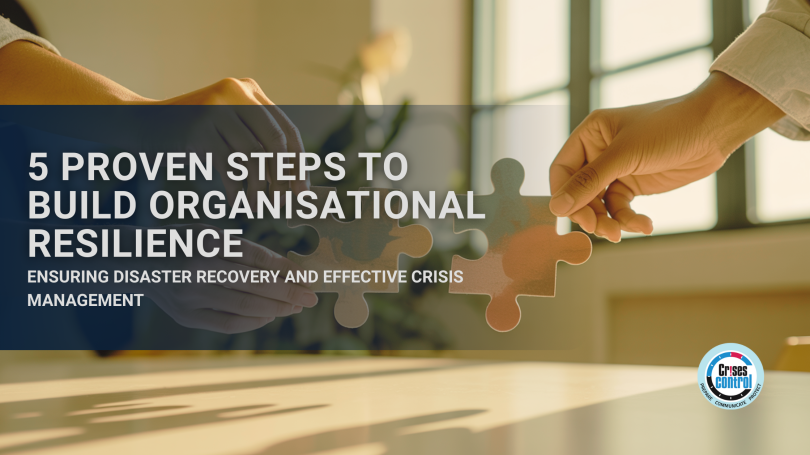Organisational resilience is a crucial aspect of any business’s long-term success. In today’s rapidly changing world, it’s essential for companies to be prepared for unforeseen circumstances, such as natural disasters, cyberattacks, or economic downturns. Building resilience within your organisation can help you navigate these challenges and emerge stronger than ever. In this blog, we will discuss five proven steps to build organisational resilience, focusing on disaster recovery and crisis management. By implementing these steps, you can ensure the survival and prosperity of your company, even in the face of adversity.
Organisational Resilience Made Easy
Step 1: Conduct a Comprehensive Risk Assessment
Before you can build resilience, you need to understand the risks your organisation may face. A thorough risk assessment enables you to identify potential threats and vulnerabilities, both internal and external. Consider conducting a SWOT analysis (Strengths, Weaknesses, Opportunities, and Threats) to gain a holistic view of your organisation’s risk landscape. This analysis will help you prioritise your efforts and allocate resources effectively.
By identifying risks specific to your industry and location, such as natural disasters, supply chain disruptions, or regulatory changes, you can tailor your resilience strategies accordingly. Remember, the key to successful risk assessment is to involve stakeholders from various departments and gather insights from both data-driven analysis and expert opinions.
Step 2: Develop a Robust Business Continuity Plan
A solid business continuity plan (BCP) is the foundation of organisational resilience. It outlines the strategies and procedures your company will follow to ensure business operations continue during and after a crisis. Your BCP should cover all critical areas, including personnel, technology, infrastructure, and key business processes.
Ensure your BCP includes:
- Clear roles and responsibilities for each team member during a crisis.
- Adequate backup and recovery mechanisms for data and systems.
- Alternative work arrangements, such as remote work or temporary office spaces.
- Contingency plans for supply chain disruptions and vendor dependencies.
- Regular testing and updating of the plan to keep it relevant and effective.
Remember, a well-documented and regularly tested BCP can significantly reduce downtime, minimise financial losses, and maintain customer trust even in the face of adversity.
Step 3: Establish Effective Crisis Communication Channels
During a crisis, effective communication is paramount. Establishing clear and reliable communication channels is crucial for disseminating information, coordinating response efforts, and keeping stakeholders informed. Here are a few key considerations:
- Designate a crisis communication team responsible for managing internal and external communications.
- Implement a multi-channel approach, including email, instant messaging, collaboration tools, and social media platforms.
- Ensure your crisis communication plan includes predefined message templates, contact lists, and escalation procedures.
- Train employees on crisis communication protocols and provide them with the necessary tools and resources.
- By prioritising transparent and timely communication, you can mitigate confusion, maintain trust, and rally support from your employees, customers, and the wider community.
Step 4: Build a Resilient IT Infrastructure
In today’s digital age, a robust and resilient IT infrastructure is critical for organisational resilience. Here are some essential steps to consider:
- Implement regular data backups and ensure off-site storage for disaster recovery purposes.
- Strengthen cybersecurity measures to protect against potential threats and data breaches.
- Leverage cloud-based services to enhance flexibility, scalability, and accessibility of your systems.
- Establish redundancy and failover mechanisms to minimise downtime and ensure continuous operation.
- Regularly update and patch software and hardware to address vulnerabilities and security risks.
Remember, investing in your IT infrastructure not only safeguards your organisation’s digital assets but also enables seamless operations during and after a crisis.
Step 5: Learn from Past Experiences and Continuously Improve
Resilience is a journey, not a destination. To build organisational resilience, it’s crucial to learn from past experiences, embrace a culture of continuous improvement, and adapt to changing circumstances. Here are some ways to achieve this:
- Conduct post-crisis reviews and identify areas for improvement.
- Encourage open and honest feedback from employees and stakeholders.
- Emphasise a growth mindset and promote a culture of innovation and agility.
- Stay informed about industry trends, emerging risks, and best practices.
- Engage in regular training and development initiatives to enhance skills and knowledge.
- By fostering a culture of resilience and adaptability, you can future-proof your organisation and stay ahead of potential challenges.
Conclusion: Take Action and Secure Your Organisation’s Future
In today’s unpredictable world, organisational resilience is more important than ever. By following the five proven steps outlined in this blog, you can build a resilient organisation capable of withstanding crises, ensuring effective disaster recovery, and maintaining continuity of operations. Remember, resilience is a continuous journey, and it requires dedication, collaboration, and a proactive mindset. Take action today and secure the future of your organisation.
To request a live demo of Crises Control‘s software and learn how our solutions can support your resilience efforts, visit our website or get in touch with our experts. Your organisation’s resilience starts now!







